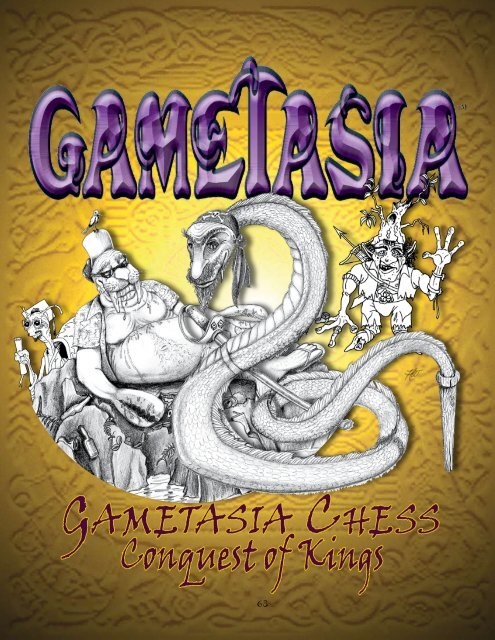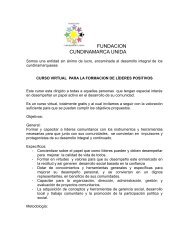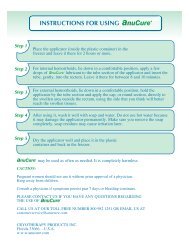Create successful ePaper yourself
Turn your PDF publications into a flip-book with our unique Google optimized e-Paper software.
<strong>Gametasia</strong> <strong>Chess</strong><br />
Conquest of Kings<br />
68
OBJECTIVE<br />
The object of <strong>Gametasia</strong> <strong>Chess</strong> is to win the highest total<br />
of Treasure Coins while capturing all your opponent’s<br />
chess pieces. The King must be captured last.<br />
GAME IN BRIEF<br />
PREPARE CHESS BOARD<br />
Number of Players: Two or four players.<br />
1. Select <strong>Chess</strong> Pieces: Choose one King ♔, one<br />
Queen ♕, two Rooks ♖ ♖, two Bishops ♗ ♗,<br />
two Knights ♘ ♘, and eight Pawns ♙ ♙ ♙ ♙ ♙ ♙ ♙ ♙.<br />
2. Card Dealer: One player is selected as the dealer<br />
and shuffles the cards, cuts the deck three times, and<br />
places the deck face down on the game board border.<br />
• Announce Card: The dealer must announce the chess<br />
piece symbol on the card drawn at the beginning of<br />
each turn.<br />
• Player Draw: Players may choose to pass the deck, in<br />
rotation, and draw their own cards.<br />
3. Coins to Players: Each of you receive the<br />
following number of Treasure Coins:<br />
• Two Player Version: 25 white, 15 red, 15 blue,<br />
15 black, and 5 green Treasure Coins totaling<br />
1500 points per player.<br />
• Stack your Treasure Coins along your<br />
border, off the chess board squares.<br />
• Four Player Allied Version: Players<br />
receive the same number of Treasure<br />
Coins as the two-player version.<br />
4. Treasure Coins Values:<br />
White Coin = 1 point.<br />
Red Coin = 5 points.<br />
Blue Coin = 10 points.<br />
Black Coin = 50 points.<br />
Green Coin = 100 points.<br />
1<br />
5<br />
10<br />
50<br />
100<br />
5. <strong>Chess</strong> Pieces to <strong>Chess</strong> Board: Position the<br />
chess board pieces in the traditional manner as<br />
illustrated on page 72 (next page). Review diagram if<br />
you are unfamiliar with chess piece opening positions.<br />
6<br />
L<br />
F 8<br />
R J VIII<br />
Cave of Daydreams<br />
Bhogavati<br />
P:1 N:2 B:3 R:4 Q:5 K:6<br />
17 34 51 85 119 153<br />
O W S<br />
o<br />
♝<br />
6<br />
L<br />
6. Play with <strong>Gametasia</strong> Cards or<br />
Standard Cards: When a <strong>Gametasia</strong><br />
Card deck is unavailable, use a standard<br />
deck of 54 poker cards. Add two extra<br />
Joker Cards to the deck of cards.<br />
70<br />
BEGIN GAME<br />
1. White Moves First: Player with the white chess<br />
pieces moves first.<br />
2. Draw Card-Announce-Move <strong>Chess</strong> Piece:<br />
Each turn begins by drawing the top card, either by<br />
the Dealer or by each opponent. Announce the chess<br />
symbol on the card, “The card is _______ King, Queen,<br />
Rook, Bishop, Knight, or Pawn!” Then, place the card,<br />
face up on the border, so players can see the symbol on<br />
the card. The symbol on the <strong>Gametasia</strong> Card determines<br />
the exact chess piece you must move.<br />
MOVE CHESS PIECE NOW!<br />
3. Movement with Standard Card Deck:<br />
If a standard deck is used, the number/rank of each<br />
card determines the chess piece movement.<br />
♟ Pawn moves with draw of a #2 or #3 card.<br />
♞ Knight moves with draw of a #4 or #5 card.<br />
♝ Bishop moves with draw of a #6, #7 or #8 card.<br />
♜ Rook moves with draw of a #9, #10 or Jack card.<br />
♕ Queen moves with draw of a Queen, Ace, or Joker.<br />
♔ King moves with draw of a King card.<br />
• After each turn, play rotates to the left, clockwise.<br />
<strong>Gametasia</strong> Card Chart: If you are not playing<br />
with <strong>Gametasia</strong> Cards, the <strong>Gametasia</strong> Card<br />
Chart on page 82 provides the proper<br />
card movement, as well as the taxes and<br />
rewards collected during each turn.<br />
4. Movement Rules: <strong>Chess</strong> pieces<br />
must be moved as follows:<br />
a) Players must move the chess<br />
piece according to the number/rank or<br />
symbol displayed on the card drawn, or<br />
that matches the chess board’s Card Square<br />
L K M N that your chess piece rests on.<br />
b) You may not remain in place if your chess piece is<br />
able to move. Movement is mandatory.<br />
c) When you cannot move your chess piece, or all<br />
pieces have been captured, pay the unable-to-move<br />
penalty—the Right of Passage Tax—to all opponents.<br />
d) When you capture an opponent’s chess piece, you<br />
collect a Reward for Capture from the opponent.<br />
5. Matching Card Suit Squares: At the<br />
beginning of your turn, if your chess piece rests on the<br />
square that matches the card you have drawn, you may<br />
either a) move the piece resting on that square, or<br />
b) move as per the card symbol (number/rank), that is,<br />
proceed with a regular move. Your choice.
chess<br />
symbol<br />
taxes<br />
&<br />
reward<br />
amounts<br />
6. Eight Treasure Squares:<br />
At the beginning of your turn, when your chess piece is<br />
positioned on one of the eight Treasure Stone Squares<br />
on the 4 borders, you may move that chess piece<br />
instead of drawing a card. Your choice.<br />
• If you move from a Treasure Square and capture an<br />
opponent’s piece, collect your reward amount from the<br />
face-up card.<br />
7. Right of Passage Tax: When you draw a<br />
card and cannot move a chess piece because your piece<br />
is trapped, you must pay a Right of Passage Tax to all<br />
opponents.<br />
• All Pieces Captured: If you cannot move a chess piece<br />
because pieces are all captured—off the chess board—<br />
pay the Right of Passage Tax to all opponents.<br />
R.O.P. Tax: To pay the Right of Passage Tax penalty you<br />
must match the card’s symbol with the letter/number at<br />
the bottom of each card. If a using standard cards, pay<br />
the amount on the <strong>Gametasia</strong> Card Chart, P:1 to K:6.<br />
• Directly beneath each of the six letter/numbers—<br />
P:1 - N:2 - B:3 - R:4 - Q:5 - K:6—is the amount of tax<br />
owed, 1 to 504 points. The Right of Passage Tax penalty<br />
is paid by matching the chess symbol to the number/<br />
letter on the bottom of each card, or as listed on the<br />
<strong>Gametasia</strong> Card Chart as per the card number:<br />
♟ If trapped, pay the amount listed under P:1.<br />
♞ If trapped, pay the amount listed under N:2.<br />
♝ If trapped, pay the amount listed under B:3.<br />
♜ If trapped, pay the amount listed under R:4.<br />
♛ If trapped, pay the amount listed under Q:5.<br />
♚ If trapped, pay the amount listed under K:6.<br />
• Pay the R.O.P Tax and your turn ends.<br />
8. Reward for Capture:<br />
Each time you capture an opponent’s chess piece, you<br />
collect a Reward for Capture in coins from opponent.<br />
• The amount collected is based on the amount indicated<br />
on the <strong>Gametasia</strong> Card Chart, or the <strong>Gametasia</strong> Card,<br />
the same card used to move your attacking chess piece.<br />
71
Beginning Positions for the <strong>Chess</strong> Pieces<br />
using the traditional version of play.<br />
The Reward Amounts:<br />
• The Reward for Capture has nothing to do with the<br />
symbol on the card’s right-hand column (unlike chess<br />
piece movement and the Right of Passage Tax where the<br />
symbol is used). The reward collected is based on the<br />
amount listed under P:1, N:2, B:3, R:4, Q:5, K:6 that<br />
matches the chess piece captured.<br />
• It is not the chess piece that does the<br />
capturing, it is the piece that gets captured<br />
that determines the Reward for Capture.<br />
For example, if you draw a #4 Card or a #5 Card<br />
with a Knight symbol and capture an enemy<br />
Rook, you collect the reward listed under<br />
Rook—R:4 on the <strong>Gametasia</strong> Card, or<br />
<strong>Gametasia</strong> Card Chart. Collect the reward for<br />
the chess piece captured.<br />
Remember, the lower ranked the<br />
capturing chess piece, the lower the<br />
amount of Reward for Capture!<br />
Reward For Capture Values:<br />
Depending on the card drawn,<br />
each chess piece has a specific<br />
reward amount value listed<br />
under the matching letter/<br />
number on the <strong>Gametasia</strong><br />
Card or <strong>Gametasia</strong> Card Chart,<br />
as follows:<br />
72<br />
♟ PAWN: P:1 = 1 point to 56 points in rewards.<br />
♞ KNIGHT: N:2 = 2 points to 112 points in rewards.<br />
♝ BISHOP: B:3 = 3 points to 168 points in rewards.<br />
♜ ROOK: R:4 = 5 points to 280 points in rewards.<br />
♛ QUEEN: Q:5 = 7 points to 392 points in rewards.<br />
♚ KING: K:6 = 9 points to 504 points in rewards.<br />
• No two cards are alike. All reward amounts different.<br />
OUT OF COINS: If you lose all your Treasure Coins,<br />
you remain in the game. If you cannot pay the full<br />
amount of a penalty, you must make a partial payment<br />
to opponent(s)—all the coins in your possession.<br />
9. Granting Mercy: You may decide to allow a highranking<br />
enemy chess piece, such as the Queen, Rook<br />
or Bishop, to escape capture from your Pawn or Knight.<br />
This is known as “granting mercy”.<br />
The reason for showing mercy to an opponent’s Queen,<br />
Rook, or Bishop can be justified based on the value of<br />
the <strong>Gametasia</strong> Card drawn. Low-ranked cards<br />
have minimal capture rewards.<br />
Right of Passage Tax: If you decide to grant mercy on<br />
an opponent’s chess piece, and you cannot move a chess<br />
piece, you must pay the Right of Passage Tax.<br />
Strategy: Use the highest ranked chess pieces with the<br />
highest valued cards for capturing enemy pieces. For<br />
example, the Q:5 card value ranges from 7 points on the<br />
#2 cards, to 392 points on the Joker Card. Waiting for a<br />
higher valued card to be drawn is good strategy.<br />
10. Checkmate: In the game of <strong>Gametasia</strong> <strong>Chess</strong>, the<br />
final chess piece captured must always be the King.<br />
At the conclusion of battle, the one, solitary King<br />
stands alone on the chess board, vulnerable<br />
for capture. Upon capturing the solitary King,<br />
“Checkmate!” is declared and the battle ends.<br />
11. End of Battle: “Victory!” is declared in<br />
the game of <strong>Gametasia</strong> <strong>Chess</strong> when your<br />
opponent’s final chess piece standing,<br />
the solitary King, is captured.<br />
• Play stops and players count their<br />
Treasure Coins.<br />
12. Winner Declared: The<br />
player or allied players with<br />
the greatest wealth, the highest<br />
Treasure Coin point total, is<br />
declared the honorary winner<br />
of <strong>Gametasia</strong> <strong>Chess</strong>, Conquest of<br />
Kings. Congratulations.
GAME IN DEPTH<br />
For those of you unfamiliar with the rules for the<br />
ancient game of chess, the following rules are provided:<br />
NUMBER OF PLAYERS<br />
You may battle one opponent in the two player version,<br />
or form an alliance with another player and battle two<br />
allied opponents.<br />
• Allies: Two players as partners form an alliance prior<br />
to battle.<br />
GAME EQUIPMENT<br />
<strong>Gametasia</strong> chess board ... 1 <strong>Gametasia</strong> Card deck with<br />
56 <strong>Gametasia</strong> Cards ... 1 Utopian Timer ... 32 chess<br />
pieces: 16 black and white chess pieces = 1 black<br />
King, 1 white Queen, 1 black and 1 white<br />
Bishop, 1 black and 1 white Rook, 1 black<br />
and 1 white Knight, 4 black and 4<br />
white Pawns ... 16 red and blue chess<br />
pieces = 1 blue King, 1 red Queen,<br />
1 blue and 1 red Bishop, 1 blue<br />
and 1 red Rook, 1 blue and 1 red<br />
Knight, 4 blue and 4 red Pawns<br />
... 300 play coins totaling 6000<br />
points as follows: 20 green coins,<br />
60 black coins, 60 blue coins, 60<br />
red coins, and 100 white coins.<br />
Black & White vs Red & Blue:<br />
When four players form two<br />
alliances, the allies must sit opposite<br />
each other during the game—the black<br />
and white chess pieces versus the red and<br />
blue chess pieces.<br />
GAMETASIA CARDS<br />
Each <strong>Gametasia</strong> Card displays a chess symbol: ♟ ♞<br />
♝ ♜ ♛ ♚ on the middle of the right-hand column.<br />
PLAYER SEATING<br />
You and your fellow players must decide where to sit<br />
based on (a) the color of the chess pieces you select and<br />
(b) whether or not you form an alliance. The four chess<br />
piece colors: black, white, red, and blue, represent<br />
Planet Millennium Underworld’s Subterranean<br />
Nations—primeval realms divided into north, south,<br />
east, and west. Depending on the version of play, two<br />
or four players, you and your opponents must sit as<br />
follows:<br />
73<br />
The Traditional Two Player Version: Two players sit<br />
opposite each other on the southern border (black<br />
and white chess pieces) and the northern border (red<br />
and blue chess pieces). One player must command the<br />
black and white chess pieces while the other player<br />
commands the red and blue chess pieces.<br />
• South Border: Command the black and<br />
white chess piece chess pieces, eight of<br />
each color.<br />
• North Border: Command the red and<br />
blue chess piece chess pieces, eight of each color.<br />
• Players must sit north and south at opposite sides of<br />
the chess board according to their color selected, with<br />
a light-colored square in the right-hand corner of the<br />
chess board.<br />
The Allied Four Player Version: When an<br />
alliance is formed (four players), the east (blue) and<br />
west (red) players form an alliance and battle<br />
the north and south players (black and<br />
white). The four players must select a<br />
specific chess piece color and sit as<br />
follows:<br />
1. Black <strong>Chess</strong> Pieces — South<br />
Border: The black chess piece<br />
player must sit at the south<br />
border.<br />
2. White <strong>Chess</strong> Pieces<br />
— North Border: The white<br />
chess piece player must sit at<br />
the north border.<br />
3. Blue <strong>Chess</strong> Pieces — East<br />
Border: The blue chess piece<br />
player must sit at the east border.<br />
4. Red <strong>Chess</strong> Pieces — West<br />
Border: The red chess piece player<br />
must sit at the west border.<br />
• If a dispute arises over seating or color<br />
selection, draw a <strong>Gametasia</strong> Card. The highest card<br />
wins. If a tie occurs, draw again until a winner is decided.<br />
• <strong>Chess</strong> Piece Color Selection: The color of the chess<br />
pieces is important in the allied version of play. The<br />
Queen is controlled by the red and white players but<br />
not the King. The King is controlled by the blue and<br />
black players, but not the Queen.<br />
PRE-GAME PREPARATION<br />
Treasure Coins:<br />
White Coin: “frugle” = 1 point each.<br />
Red Coin: “scruple” = 5 points each.<br />
Blue Coin: “oodle” = 10 points each.<br />
Black Coin: “simolean” = 50 points each.<br />
Green Coin: “moolah” = 100 points each.<br />
W<br />
N<br />
S<br />
E
The two player version: Each opponent receives 1500<br />
points worth of Treasure Coins as follows: 5 green<br />
coins (500 pts.); 15 black coins (750 pts.); 15 blue<br />
coins (150 pts.); 15 red coins (75 pts.); and 25 white<br />
coins (25 pts.).<br />
• When playing the four player allied version, each<br />
opponent receives the same amount of coins as the twoplayer<br />
version.<br />
• Stack your Treasure Coins along your border, off the<br />
chess board squares—the <strong>Chess</strong> Stones.<br />
<strong>Gametasia</strong> Cards: Prepare the deck of fifty-six (56)<br />
<strong>Gametasia</strong> Cards as follows:<br />
• Shuffle the card deck thoroughly and cut the deck<br />
three times.<br />
• Place the <strong>Gametasia</strong> Card deck face down in one of the<br />
game board corners.<br />
• Discard Deck is Face Up: Cards are placed<br />
face up in the opposite corner, forming the discard deck.<br />
Deck Depleted: If the <strong>Gametasia</strong> Card deck<br />
is depleted during play, re-shuffle the deck, cut<br />
three times, and place the card deck face down.<br />
CHESS PIECES<br />
The game of <strong>Gametasia</strong> <strong>Chess</strong> features the six<br />
traditional chess pieces: King, Queen, Bishop, Rook,<br />
Knight, and Pawn in four different colors: black, white,<br />
red, and blue. The 8 black and 8 white chess pieces are<br />
alternated between the light and dark squares on the<br />
south border, and the 8 red and 8 blue chess pieces are<br />
alternated between the light and dark squares on the<br />
north border.<br />
Two Player Version: Each player receives<br />
sixteen (16) chess pieces, either black and white or red<br />
and blue as follows:<br />
• 1 King: either black or blue.<br />
• 1 Queen: either white or red.<br />
• 2 Bishops: 1 black and 1 white, or 1 red and 1 blue,<br />
depending on the color selected.<br />
• 2 Rooks: 1 black and 1 white, or 1 red and 1 blue,<br />
depending on the color selected.<br />
• 2 Knights: 1 black and 1 white, or 1 red and 1 blue,<br />
depending on the color selected.<br />
• 8 Pawns: 4 black and 4 white, or 4 red and 4 blue,<br />
depending on the color selected.<br />
Four Player Allied Version: Each player receives<br />
eight (8) chess pieces, either black, white, red, or blue:<br />
1. Black Player Positioned At The South Border: 1 black<br />
King, 1 black Bishop, 1 black Rook, 1 black Knight, and<br />
4 black Pawns positioned at the southern border. The<br />
black chess pieces are the only pieces that the black<br />
player may move during the game.<br />
2. White Player Positioned At The South Border: 1 white<br />
Queen, 1 white Bishop, 1 white Rook, 1 white Knight,<br />
and 4 white Pawns positioned at the southern border.<br />
The white chess pieces are the only pieces the white<br />
player may move during the game.<br />
3. Red Player Positioned At The North Border: 1 red<br />
Queen, 1 red Bishop, 1 red Rook, 1 red Knight, and 4<br />
red Pawns positioned at the northern border. The red<br />
chess pieces are the only pieces that the red player may<br />
move during the game.<br />
4. Blue Player Positioned At The North Border: 1 blue<br />
King, 1 blue Bishop, 1 blue Rook, 1 blue Knight, and 4<br />
blue Pawns positioned at the northern border. The blue<br />
chess pieces are the only pieces that the blue player may<br />
move during the game.<br />
CHESS PIECE POSITIONS<br />
Prior to battle, you and your opponent(s) must position<br />
chess pieces on a specific squares on the chess board.<br />
When viewing the chess board in a north and south<br />
direction, the rows of squares that run across are<br />
RANKS, and the squares that run up and down are<br />
FILES. The slanting rows are DIAGONALS.<br />
♙ Dwarve Pawns: Position your chess pieces on the<br />
rank nearest you with the eight Pawns positioned on<br />
the rank in front of the other chess pieces. You must<br />
alternate the two colors: the black and red pieces on the<br />
dark colored squares, and the white and blue pieces on<br />
the light colored squares.<br />
• In traditional chess, position the white pieces on the<br />
north border and the black pieces on the south border.<br />
♜ Dragon Rooks: The two Rooks occupy the two corner<br />
squares, left and right.<br />
♞ Noble Knights: The two Knights stand next to the<br />
Dragon Rooks.<br />
♝ Wizard Bishops: The two Bishops stand beside the<br />
Noble Knights.<br />
♛ Queen: The Queen occupies the central stone square<br />
of its own color or shade. The red Queen begins on<br />
a dark-colored square (north border) and the white<br />
Queen begins on a light-colored square (south border).<br />
♚ King: The King stands next to his Queen. The black<br />
King occupies the dark-colored square (south border)<br />
and the blue King occupies the light-colored square<br />
(north border).<br />
• The opposing Queen and King face each other across<br />
the chess board.<br />
74
North<br />
KING<br />
K:6<br />
BISHOP<br />
B:3<br />
QUEEN<br />
Q:5<br />
KNIGHT<br />
N:2<br />
ROOK<br />
R:4<br />
PAWN<br />
P:1<br />
CHESS PIECE MOVEMENT<br />
After you draw a card indicating the chess piece to be<br />
moved, each chess piece has a specific move as follows:<br />
South<br />
♕ Queen: Your Queen is the most powerful<br />
chess piece. You may move your Queen in any<br />
direction along a rank, file, or diagonal until the<br />
Queen’s path is blocked by another chess piece.<br />
75<br />
♔ King: Your King also moves in any<br />
direction, but only one square at a time.
♖ Rook: Your Dragon Rook may move along<br />
any rank or file until your Rook’s path is<br />
blocked by another chess piece.<br />
♘ Knight: Your Noble Knight is the only chess piece<br />
that is able to change direction during the<br />
course of the move and “jump over” your own<br />
or an opponent’s chess pieces. Knights move<br />
in an “L” pattern; that is, two ranks up or<br />
down and one file left or right; or one rank up<br />
or down and two files left or right.<br />
♗ Bishop: Your Wizard Bishop may move<br />
along any diagonal until your Bishop’s path<br />
is blocked by another chess piece.<br />
• Bishops must stay on the color squares they<br />
start on.<br />
76<br />
♟ Pawn: Each of your Dwarve Pawns may advance only<br />
one square at a time except on each Pawn’s first<br />
move, when it may advance either one (1) square<br />
or two (2) squares forward. Your choice.<br />
• Pawns capture diagonally, either left or right.
RULES OF MOVEMENT<br />
• You must move the chess piece displayed on the<br />
<strong>Gametasia</strong> Card drawn, or the card’s number/rank.<br />
• When you cannot move your chess piece—trapped or<br />
off board—your must pay a penalty for non-movement,<br />
called the Right of Passage Tax, to all opponents.<br />
• When you capture an enemy chess piece, you collect a<br />
Reward for Capture from the opponent.<br />
• Matching Card Squares: At the beginning of<br />
your turn, if your chess piece rests on<br />
the square that matches the card you<br />
have drawn, you may either:<br />
a) move the chess piece resting on<br />
that square, or<br />
b) move as per the card symbol/<br />
number. Your choice.<br />
• Treasure Squares:<br />
When your chess piece is positioned<br />
on one of the eight Treasure<br />
Squares at the beginning of your<br />
turn, you may move that chess<br />
piece instead of drawing a card.<br />
Your choice.<br />
• If you move from a Treasure<br />
Stone Square and capture an<br />
opponent’s piece, collect your<br />
reward amount from the face-up<br />
card.<br />
• The eight (8) Treasure Squares<br />
consist of two (2) Diamonds L:<br />
the Eternal Rose and the Golden<br />
Egg of Enlightenment; two<br />
(2) Clubs K: the Cauldron of<br />
Regeneration and the Magic Hive;<br />
two (2) Hearts M: the Treasure<br />
Chest of Ethics and the Well of Wishes<br />
with the Jar of Joy; two (2) Spades N:<br />
the Diamond of Desire and the Pot of<br />
Gold—all on the middle of the outside border squares.<br />
CAPTURE<br />
A capture occurs when an opponent’s chess piece stops<br />
the progress of an attacking chess piece. When you<br />
capture an enemy chess piece, you must remove it from<br />
the chess board and replace it on the square it occupied<br />
with your attacking chess piece.<br />
• Place all captured chess pieces along your border off<br />
the board, then collect your Reward for Capture from<br />
opponent, 1 point to 504 points.<br />
• Any chess piece in danger of being captured is<br />
considered “under attack”.<br />
Pawn Capture: Your Pawn is the only chess piece<br />
that does not capture an enemy chess piece straight in<br />
its path. Instead, your Pawn captures an enemy piece<br />
one square to the left or the right of the square in front<br />
of your Pawn—diagonally (see diagram on Page 120).<br />
EN PASSANT<br />
Your Pawn may also capture “en passant” (French for<br />
“in passing”) when your Pawn is on the fifth rank and<br />
an enemy Pawn on a neighboring file advances two<br />
squares “past your Pawn”. You may capture the enemy<br />
Pawn as if it had moved only one square, but it must<br />
be captured before it advances an additional square.<br />
PAWN PROMOTION<br />
If your Pawn reaches the rank farthest away, the rank<br />
of the enemy King, you may promote<br />
your Pawn for ANY chess piece<br />
except a King. Since players usually<br />
exchange Pawns for Queens, this<br />
promotion is known as “Queening the Pawn”.<br />
The Pawn promotion occurs as follows:<br />
• When your Pawn reaches the farthest<br />
rank, remove your Pawn from the chess<br />
board and replace it with a previously<br />
captured Queen, or the chess piece of your<br />
choice. Keep track of the promoted Pawn.<br />
• If a second Pawn, and so on, is<br />
promoted, you must try to<br />
replace each of your Pawns<br />
with a previously captured<br />
chess piece acquired from an<br />
opponent; otherwise, keep track<br />
of your promoted Pawns.<br />
CASTLE<br />
You may choose to “castle” in order<br />
to protect your King from attack.<br />
This is the only move during which<br />
you may move two chess pieces at the same<br />
time. Castling counts as one turn, instead of drawing a<br />
card, and occurs as follows:<br />
• To castle, instead of drawing a card, you must declare,<br />
“Castle!” and move your King two squares toward either<br />
Rook and then place your Rook on the square the King<br />
passed over.<br />
• You may castle only if your King and Rook have not<br />
previously been moved and if no other chess pieces<br />
stand between them.<br />
• You may not castle if your King is under immediate<br />
attack, known as “check”; or if the square your King<br />
crosses or the square the King lands on puts your King<br />
in check.<br />
77
FIRST MOVE<br />
To begin <strong>Gametasia</strong> <strong>Chess</strong>, the Dealer, or the starting<br />
player, draws a <strong>Gametasia</strong> Card from the card deck,<br />
announces the chess symbol on the card, and places<br />
the <strong>Gametasia</strong> Card face up on the border’s discard pile.<br />
According to the <strong>Gametasia</strong> Card’s symbol in the righthand<br />
column—♟ ♝ ♞ ♜ ♛ ♚—the player moves his<br />
or her appropriate chess piece.<br />
• The face-up card forms the discard stack for the<br />
remainder of the game.<br />
• After each player’s turn, play rotates to the left, clockwise.<br />
Utopian Timer: During your turn, as soon as you draw<br />
a <strong>Gametasia</strong> Card, the opponent across the<br />
<strong>Gametasia</strong> board (or to your left), must<br />
activate a timer. You have one minute<br />
(sixty seconds) to move a chess<br />
piece or you must pay the Right<br />
of Passage Tax based on K:6 of<br />
the face-up card. When you<br />
pay the Right of Passage Tax,<br />
you cannot move. Your turn<br />
is over.<br />
Time Consensus: You and your opponent or<br />
allied group may decide to allow more time<br />
for each player to move their chess piece.<br />
Two minutes, three minutes, five minutes,<br />
or any amount of time is acceptable, as<br />
long as all players reach a consensus.<br />
CHESS CARD SYMBOLS<br />
The fifty-six (56) <strong>Gametasia</strong> Cards<br />
and the <strong>Gametasia</strong> Card Chart serve<br />
three purposes.<br />
• First, each card dictates the exact<br />
chess piece to be moved during your<br />
turn.<br />
• Second, the same <strong>Gametasia</strong> Card<br />
used for movement also indicates<br />
the Reward for Capture<br />
amount.<br />
• Third, the Right of<br />
Passage Tax is listed on<br />
each card, as well as<br />
the <strong>Gametasia</strong> Card<br />
Chart.<br />
Card Movement Symbol: Each <strong>Gametasia</strong><br />
Card displays a symbol on the right-hand<br />
column indicating the exact chess piece to<br />
be moved, either your King ♚, Queen ♛,<br />
Rook ♜, Bishop ♝, Knight ♞ , Pawn ♟.<br />
78<br />
Power & Rank of <strong>Chess</strong> Pieces: At the<br />
bottom of each <strong>Gametasia</strong> Card is a row of six (6)<br />
letters/numbers: P:1 - N:2 - R:3 - B:4 - Q:5 - K:6.<br />
Each of the six letter/numbers represents the power<br />
and rank, the hierarchical position, of each chess piece<br />
in the following order:<br />
♟ P:1 = The Pawn has a power of 1 and is the<br />
lowest ranked chess piece.<br />
♞ N:2 = The Knight has a power of 2 and is the<br />
second to lowest ranked piece, out ranking the Pawn.<br />
♝ B:3 = The Bishop has a power of 3 and out ranks<br />
the Knight and Pawn.<br />
♜ R:4 = The Rook has a power of 4 and out ranks the<br />
Bishop, Knight and the Pawn.<br />
♛ Q:5 = The Queen has a power of 5<br />
and is the second ranked chess piece, out<br />
ranking the Bishop,<br />
Rook, Knight, and Pawn.<br />
♚ K:6 = The King has a power of 6 and is<br />
the first ranked chess piece, out ranking all<br />
other chess pieces.<br />
RIGHT OF<br />
PASSAGE TAX<br />
Whenever you draw a <strong>Gametasia</strong><br />
Card and cannot move a chess piece,<br />
your piece is trapped and you must<br />
pay a Right of Passage Tax to all<br />
opponents. If you draw the card of a<br />
piece “off the board” (all captured),<br />
you pay a Right of Passage Tax to all<br />
opponents.<br />
• To pay the Right of Passage Tax<br />
penalty you must match the<br />
card’s symbol with the letter/<br />
number at the bottom of each<br />
card or the <strong>Gametasia</strong> Card Chart.<br />
Tax Penalties: Directly beneath<br />
each of the six (6) letter/numbers<br />
listed as P:1 - N:2 - B:3 - R:4 - Q:5 - K:6—is the<br />
amount of tax owed, 1 to 504 points. The Right of<br />
Passage Tax penalty is paid by matching the chess symbol<br />
to its number/letter on the bottom of each card:<br />
♙ = Pay the tax listed under P:1 on card or chart.<br />
♘ = Pay the tax listed under N:2 on card or chart.<br />
♗ = Pay the tax listed under B:3 on card or chart.<br />
♖ = Pay the tax listed under R:4 on card or chart.<br />
♕ = Pay the tax listed under Q:5 on card or chart.<br />
♔ = Pay the tax listed under K:6 on card or chart.<br />
• After paying the Right of Passage Tax, your turn ends.
At the beginning of battle, prepare to pay the Right of<br />
Passage Tax several times because the only two chess<br />
pieces that you may move without interference are<br />
your Pawns and Knights.<br />
REWARD FOR CAPTURE<br />
Each time you capture an opponent’s chess piece, you<br />
collect a Reward for Capture in Treasure Coins from the<br />
opponent. The amount collected is based on the amount<br />
indicated on the <strong>Gametasia</strong> Card—the same card used<br />
to move your attacking, or capturing, chess piece. The<br />
reward amounts are determined as follows:<br />
• The Reward for Capture has nothing to do with the<br />
symbol on the card’s right-hand column, unlike the<br />
chess piece movement and the Right of Passage Tax<br />
where the symbol is used.<br />
• The reward collected is based solely on the amount<br />
listed under P:1, N:2, B:3, R:4, Q:5, K:6 matching the<br />
chess piece captured.<br />
For example, if you draw a card with a Wizard Bishop<br />
symbol and capture an enemy Dragon Rook, you<br />
collect the reward listed under R:4 on the <strong>Gametasia</strong><br />
Card, the piece captured. Capture a Queen, collect Q:5<br />
reward.<br />
• It is not the chess piece that does the capturing, it is<br />
the piece that gets captured when collecting the<br />
Reward for Capture.<br />
Reward For Capture Values: Depending on the<br />
<strong>Gametasia</strong> Card drawn, each chess piece has a specific<br />
reward amount value listed under the matching letter/<br />
number as follows:<br />
♟ PAWN: P:1 = 1 point to 56 points in coins.<br />
♞ KNIGHT: N:2 = 2 points to 112 points in coins.<br />
♝ BISHOP: B:3 = 3 points to 168 points in coins.<br />
♜ ROOK: R:4 = 5 points to 280 points in coins.<br />
♛ QUEEN: Q:5 = 7 points to 392 points in coins.<br />
♚ KING: K:6 = 9 points to 504 points in coins.<br />
• No two cards are alike. Reward amounts are different.<br />
OUT OF TREASURE COINS<br />
If you lose all your Treasure Coins during battle, you<br />
continue to compete. Until you win more coins, you<br />
do not pay Right of Passage Tax or Reward for Capture<br />
penalties to your opponents. However, even if you<br />
79
cannot pay a FULL penalty, you must make partial tax<br />
payments (all coins in your possession) as long as you<br />
have Treasure Coins.<br />
• Allied Players: Your allied partner must pay all tax<br />
penalties owed by you as long as your ally has the<br />
ability to pay.<br />
ALLIED FORCES<br />
If two players form an alliance, they may advise each<br />
other regarding moves and game strategy. Treasure<br />
Coins are shared in the event one ally cannot pay a<br />
Reward for Capture. Allies must pay each other’s debts.<br />
GRANTING MERCY<br />
You may decide to allow a high-ranking enemy chess<br />
piece, such as the Queen, Rook, or Bishop, to escape<br />
capture. This is known as<br />
“granting mercy”.<br />
• The reason for showing<br />
the Queen, Rook, or Bishop<br />
mercy is justified based<br />
on the value of the drawn<br />
<strong>Gametasia</strong> Card.<br />
For example, the Q:5<br />
card value ranges from 7<br />
points on the #2 Cards<br />
to 392 points on the<br />
Joker Card. Therefore,<br />
waiting for a<br />
higher valued<br />
card to be<br />
drawn is<br />
often a wise<br />
decision—a<br />
valid<br />
consideration.<br />
However, the<br />
opponent’s<br />
piece you grant<br />
mercy to could<br />
escape if an incorrect<br />
card is drawn. The value<br />
of each card must be considered<br />
before granting mercy.<br />
Right of Passage Tax: If you decide to grant mercy on<br />
an opponent’s chess piece and you cannot move a chess<br />
piece, you must pay the Right of Passage Tax.<br />
80<br />
KING IN CHECK<br />
In the game of <strong>Gametasia</strong> <strong>Chess</strong>, the final chess piece<br />
captured must always be the King.<br />
• When you are positioned to attack the opponent’s<br />
King, it is customary to give notice to your opponent by<br />
announcing, “Check!”. However, declaring “Check!” is<br />
not mandatory.<br />
• If your King is in check, you must move only to rescue<br />
your King; specifically, you must either:<br />
a) capture the attacking chess piece, b) move your King<br />
to a square that is not under attack, or c) in traditional<br />
chess, move another chess piece between your King and<br />
the attacking chess piece, known as interposition.<br />
CHECKMATE<br />
In traditional chess, if you are unable to rescue your<br />
King in check, the game would end in checkmate with<br />
the attacking player winning. In <strong>Gametasia</strong> <strong>Chess</strong>,<br />
checkmate takes place with the actual capture of the<br />
King—the highest ranked and most valuable piece.<br />
• When you announce “Check!” and your opponent is<br />
unable to rescue his or her King because an incorrect<br />
chess card is drawn, drawing the correct chess card on<br />
your next turn allows you to announce “Checkmate!”<br />
Capture the solitary King, collect the reward and the<br />
battle ends.<br />
END OF BATTLE<br />
“Victory!” is declared when<br />
your opponent’s final chess<br />
piece, the solitary King,<br />
is captured. Play stops<br />
and players count their<br />
Treasure Coins.<br />
WINNER<br />
DECLARED<br />
The player or the allied players<br />
with the greatest wealth, the<br />
highest Treasure Coin point total, is<br />
declared the winner of <strong>Gametasia</strong> <strong>Chess</strong>,<br />
Conquest of Kings.<br />
GAMETASIA CARD CHESS<br />
To play a simplified version of <strong>Gametasia</strong> <strong>Chess</strong>,<br />
eliminate the Treasure Coins and play <strong>Gametasia</strong> Card<br />
<strong>Chess</strong>. Follow the same rules but omit the Rewards for<br />
Capture or Right of Passage taxes. <strong>Gametasia</strong> Card<br />
<strong>Chess</strong> ends with the capture of the enemy King.
















